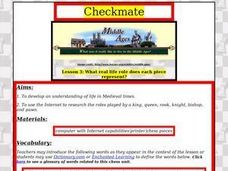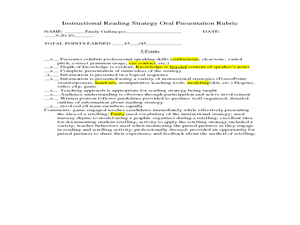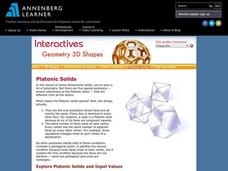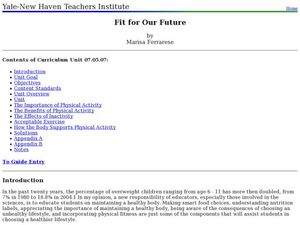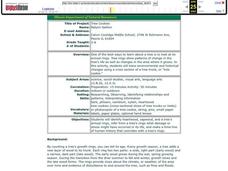Curated OER
Checkmate: Chess, and the connection to the Middle Ages
Students investigate the different aspects of Medieval Times and the connection to chess. In this world history lesson, students complete a chart answering questions about the lifestyles of men and women in the Medieval Times....
Curated OER
TechnoKnight
Students examine world history by creating arts and crafts. In this middle ages lesson, students discuss the relevence of items such as a helmet, shield and family crest. Students complete middle ages worksheets, create historic...
Discover Earth
Weather Stations
Transform your classroom into a fully functioning weather station with this series of hands-on investigations. Covering the topics of temperature, precipitation, wind patterns, and cloud formation, these activities engage young...
Bright Hub Education
Advertisement Analysis
Middle schoolers review magazine ads and take a look at some of the most common advertising techniques. From analyzing these ads, youngsters begin to become aware of how advertisers target specific age groups, gender groups, and how they...
Curated OER
The Art of Making Paper
Students discover the materials used to make paper in the late Middle Ages and coompare that to papermaking today. In groups, they analyze and compare the effectiveness, cost and value of the various materials available. They discuss the...
Curated OER
Retelling
Explore language arts by completing a story worksheet in class. Readers will identify the importance of plot, setting, and character while they write their own short story. They also retell their story to a classmate and participate in a...
Baylor College
There's Something in the Air
Clever! In order to compare indoor and outdoor dispersal rates for the movement of gases and particles through air, collaborators will participate in a classroom experiment. Set up a circular grid and set students on lines that are...
Annenberg Foundation
Geometry 3D Shapes: Euler's Theorem
How do you get a theorem named after you? Euler knows what it takes! The third lesson of five asks pupils to use an interactive activity to compare the faces, vertices, and edges of seven different three-dimensional solids. They use...
Curated OER
What's So Bad or Good About Conflict?
Learners of all ages discuss how conflict can be negative and positive. First, they create a class bulletin board about conflict, and provide their thoughts and connotations surrounding the word. In a class discussion, they ask questions...
Curated OER
Methods of Mystery
Students utilize the scientific method to discover the age of an item. In this historical dating lesson plan, students compare and contrast a 400 year old cabinet to one made within a few years by using carbon dating....
Curated OER
A Sample of What?
Young scholars are introduced to the connection between women and the textile industry. Using primary source documents, they complete a handout on how gender roles have changed over the years. They examine a sampler which is connected to...
Annenberg Foundation
Geometry 3D Shapes: Platonic Solids
From polyhedrons to platonic solids, here is a lesson that will have your classes talking! As an introduction to platonic solids, scholars cut and fold nets to create the three-dimensional solids. They use an interactive component to...
Curated OER
Fit for Our Future
Students understand the importance of physical fitness as part of a healthy lifestyle. In this health lesson students create a display and presentation about what they learned.
Curated OER
Medieval Ethiopia, Mali and Nigeria: The Influence of Culture in Africa
Students are introduced to the concept of cultural diffusion. In groups, they identify the culture of Mali, Nigeria and Ethiopia and work together to research how cultural diffusion has changed the country. To end the lesson, they...
Curated OER
Life Science- Useful Waste
Fourth graders explore the topic of waste and recycling. In this useful waste lesson, 4th graders classify objects and sort them into most usable and least usable categories. Students complete an activity sheet and have a discussion on...
Curated OER
Primary Structural Forms: Post and Beam
Students examine the three primary structural forms of architecture. They view photos, take a walking tour of their community, conduct strength tests of post, beam, and arch construction, and analyze the test results.
Curated OER
What's the Difference?
Students explore the differences between acoustic and digital pianos. In this music lesson plan, students listen to an acoustic piano and digital piano. Students play both types of pianos and discuss the differences.
Curated OER
Media as a Representation of Reality
Students examine different viewpoints and representations of events. They discover that viewpoints are constructed from different points of view. They also examine how they represent real events.
Curated OER
Tree Cookies
Students identify heartwood, sapwood, and a tree's annual rings, infer from a tree's rings what damage or stress might have occurred in its life, and make a time-line of human history that coincides with a tree's rings.
Curated OER
Animal Adaptations
Fifth graders discover the adaptation of species through analyzing pictures. In this scientific discovery lesson, 5th graders discuss the concept of adaptation in order for survival. Students view many images of extinct...
